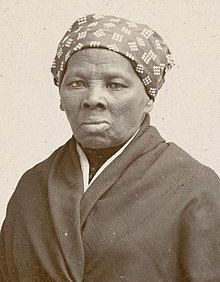"by white people . . .>
- Penny Colman
- Oct 6, 2023
- 2 min read

I like timelines: Recently I have been working on one about landmarks for Harriet Tubman, one of America's most memorialized historic women.
(Left image, click to enlarge)): A bronze plaque with a bas relief of Harriet Tubman, based on a 1895 photograph is the first one. Dedicated on June 12, 1914, a year after her death, the plaque is affixed by the front door of the Cayuga County Court House, Auburn, New York. The memorial was noted in newspaper accounts as "paid for by white people." A great audience attended the Friday evening dedication ceremony. Booker T. Washington, who was born into slavery and became a prominent leader, educator, orator, and presidential advisor, gave the main address. Mrs. Mary B. Talbert, president of the Empire State Federation and chair of the Executive Committee of the National Association of Colored Women, recounted the story of Harriet Tubman's life and legacy. (Right Image: Mary B. Talbert and the caption from my book The Vote: Women's Fierce Fight, p. 311.)

I first visited the plaque in 1993. To me it appeared based on a 1895 photograph of Harriet Tubman. (Left image)

I liked that the uncredited artist, depicted Harriet Tubman as fierce, firm, and forceful, a don't-mess-with-me visage. It matched the women I wrote about in Spies: Women in the Civil War who led a raid up the Combahee River and freed 700 enslaved people.
In his book published in 1916, Emancipation and the Freed in American Sculpture: A Study in Interpretation, Freeman H. M. Murray, a Black journalist, scholar, activist, devoted a chapter to "The Harriet Tubman Tablet," and scathingly trashed the bas relief of Tubman: He decried her "haggish physiognomy" and wrote—"It is difficult to view the facial features of this heroine as depicted on this tablet without wincing . . .This woman whose life-history is like a romance and a hero tale combined, lived, it is true, to a great age; but it is probably that for relatively only a short period of her life, were her features a shriveled, mis-sharpened, and pitifully distorted, as they are depicted here—if indeed they ever were."
Murray acknowledged that the "people of Auburn," where Tubman had lived for many years, "probably had no intention to ridicule her."
So, what to make of our glaringly different responses to Tubman's bas relief? Clearly we are vastly different people. He lived in a different historical times. He's male. I'm not. He's Black. I'm not. But more than all that I am struck by Murray's use of the word "romance," an unimaginable word for me to associate with Harriet Tubman's "life-history."
The 1914 Harriet Tubman Memorial unveiling in Auburn, New York, was widely reported. Below are three headlines cropped from newspapers, each with its own perspective. (The text on the plaque appears in the third image.)
"Fine Memorial Is Erected To Negro Heroine," Democrat and Chronicle, (Rochester, NY), July 8, 1914, p. 3.
"Unusual Honors For Negress Who Rescued Slaves," The Ithaca Journal, (Itaca, New York),July 8, 1914, p. 3.
"Memorial to Harriet Tubman, The Colorado Statesman, (Denver, Colorado),June 27, 1914, p. 1.






Comments